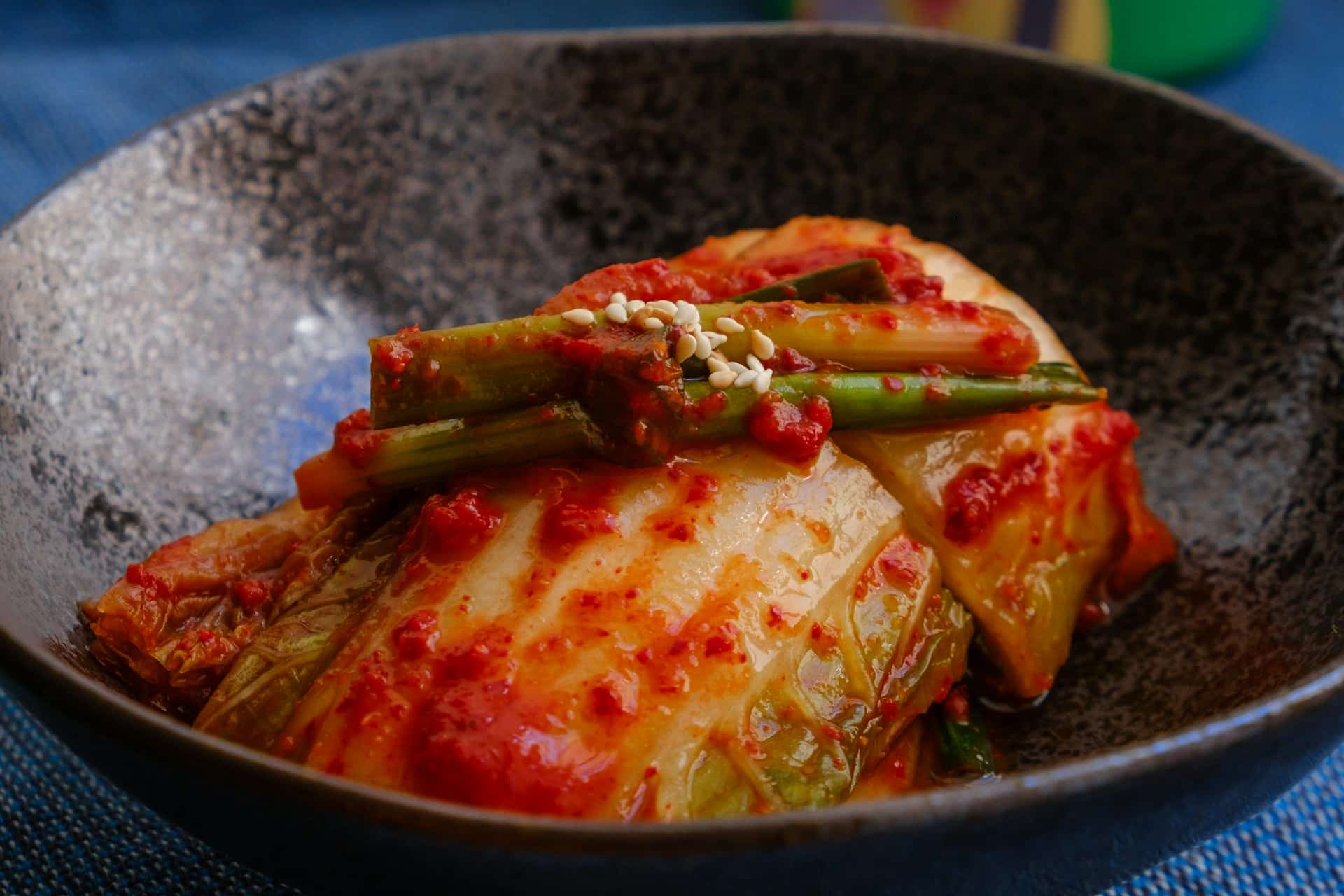What’s the Best Way to Ferment Your Own Kimchi Using Traditional Korean Methods?

Kimchi, an emblematic dish of Korean cuisine, is a fermented, spicy cabbage-based recipe that is rich in flavor and health benefits. A staple in every Korean household and a must-try for food enthusiasts, kimchi’s popularity has spread far beyond the Korean peninsula, reaching kitchens worldwide. For those of you who have a taste for this tangy, aromatic condiment, this article aims to guide you on how to make your own traditional Korean kimchi at home.
Choosing the Right Ingredients for Your Kimchi
Before you start making your kimchi, it’s crucial to gather the right ingredients. The ingredients are not just an important part of the recipe but also the foundation of the unique flavor that defines kimchi.
Avez-vous vu cela : What’s the Key to a Perfectly Tender and Flavorful Indian Chicken Korma?
First and foremost, you’ll need cabbage. In traditional Korean kimchi, Napa cabbage, known for its sweet and mild flavor, is the vegetable of choice. However, other leafy greens like bok choy can also be used.
Next, you will require salt and water to create a brine solution. The brine is crucial in the initial stages of fermentation, helping to keep the cabbage crunchy and tangy.
Avez-vous vu cela : How to Perfectly Poach Pears in Red Wine for an Elegant Dessert?
The heart of kimchi’s flavor lies in its sauce or paste, which requires Korean chili powder, garlic, ginger, and fermented fish sauce. These ingredients are blended together to create a paste that is both spicy and aromatic, adding a unique kick to the cabbage.
Lastly, additional vegetables such as radish and scallions are added to the mix for an extra crunch and flavor.
Preparing the Cabbage for Fermentation
After sourcing your ingredients, the first step in making kimchi is preparing the cabbage. You will need to cut the cabbage into quarters, remove the core, and then chop the leaves into bite-size pieces. Once this is done, soak these pieces in a brine solution made from a ratio of half a cup of salt to every four cups of water. The salt draws out the water from the cabbage, creating an ideal environment for the fermentation process to begin.
Leave the cabbage to soak in this brine for up to 12 hours, or until it becomes slightly soft and pliable. During this process, make sure to turn the cabbage pieces occasionally to ensure all the pieces are evenly soaked.
Making the Kimchi Paste
While your cabbage is soaking in the brine, you can start preparing the kimchi paste. The paste is what gives kimchi its distinguishing flavor, and it’s critical to get it right.
To make the paste, blend together garlic, ginger, sugar, Korean chili powder, and fish sauce. The fish sauce, a fermented product itself, adds an umami flavor and helps kickstart the fermentation process in your kimchi.
You may add a cup of sweet rice flour paste to thicken the sauce, but this is optional. Once the paste is ready, add in the chopped radish and scallions, making sure everything is well-coated.
Assembling and Fermenting Your Kimchi
When the brined cabbage is ready, rinse it thoroughly under cold water to remove any excess salt. Squeeze out the remaining water and combine it with the kimchi paste. Make sure that every leaf is well coated with the paste.
Once your cabbage and paste are thoroughly mixed, pack the mixture tightly into a clean glass jar or a crock, ensuring there are no air pockets. This is essential as exposure to air can lead to mold growth and spoil your kimchi.
The fermentation process begins as soon as the cabbage is packed into the jar. It is recommended to let your kimchi ferment at room temperature for about two days before moving it to the refrigerator.
Monitoring the Fermentation Process
Kimchi fermentation is an art, and like all arts, it requires patience and observation. As your kimchi ferments, the flavors will progressively deepen, becoming more sour and umami-rich over time.
It’s crucial to monitor the fermentation process, and you can do so by tasting the kimchi every day. If the kimchi tastes tangy and flavorful, it’s ready to eat. If you prefer a more sour flavor, you can let it ferment for a little longer.
Note that fermentation can take longer in colder temperatures, and shorter in warmer temperatures. So keep this in mind, especially if you’re making kimchi during different seasons.
Don’t be alarmed if you see bubbles in the jar or if the kimchi juices overflow. This is a natural part of the fermentation process as the beneficial bacteria produce gases.
And there you have it- your own homemade, delicious, and probiotic-rich traditional Korean kimchi. Once you’ve mastered this basic recipe, don’t hesitate to experiment with different vegetables or adjust the spice levels to suit your taste.
The Role of Different Ingredients in Your Kimchi
Let’s take a closer look at the critical roles played by the different ingredients in your kimchi recipe. As mentioned before, Napa cabbage is the star of traditional Korean kimchi. This vegetable holds its structure even after the fermentation process, providing the crunchy texture that’s loved by kimchi fans worldwide.
Sea salt is an essential ingredient in making kimchi. Not only does it season the cabbage, but it also draws out water from the cabbage to create the perfect environment for lactic acid bacteria- the species responsible for the fermentation process.
Next comes Korean chili powder or red pepper flakes. This is what gives kimchi its fiery red color and a kick of spiciness.
Garlic and ginger are also essential for flavor and are known for their abundant health benefits, including aiding digestion.
Fish sauce is an integral part of the kimchi recipe. It adds an umami flavor that helps intensify the overall taste of the kimchi. Plus, as a fermented product itself, it aids in speeding up the fermentation process of the kimchi.
Among the additional vegetables, daikon radish and green onions, also known as scallions, are commonly used. They contribute extra crunch, freshness, and flavor.
Finally, to make the kimchi paste thicker and stick better to the cabbage leaves, sweet rice flour is sometimes used. It’s added to water and boiled until it forms a thick paste.
Variations and Uses of Your Homemade Kimchi
Once you’ve mastered the traditional Baechu (cabbage) kimchi, you can start experimenting with different variations. Kimchi isn’t limited to Napa cabbage. You can make kimchi using other vegetables like cucumbers, radishes, or even fruit like apple and pear for a unique twist.
Another interesting variation is adding seafood to your kimchi for added flavor. Common additions include fresh or salted shrimp, squid, and oysters.
Kimchi is not just a side dish. It’s a versatile ingredient that can be incorporated into various dishes. You can use kimchi to spice up your morning eggs, add it to your fried rice for a tangy twist, or even top it on your pizza or burger for a unique fusion dish! You can also make kimchi soup, also known as kimchi jjigae, a comforting, spicy, and hearty Korean stew.
Conclusion
Making your homemade kimchi using traditional Korean methods can seem like a daunting task, but once you get the hang of it, it’s quite simple and immensely satisfying. Remember, the secret to great kimchi lies in the quality of your ingredients and your patience during the fermentation process.
While it’s essential to respect the traditional kimchi recipe, don’t hesitate to be creative and try different variations to suit your taste. Whether you’re eating your kimchi straight from the jar or using it as an ingredient in your fried rice or stew, the complexity and depth of flavor it adds to your dishes are unmatched.
So, start making your kimchi and discover the wonders of this tangy, spicy, and umami-rich Korean delight that’s not just delicious but also packed with probiotics and full of health benefits!
